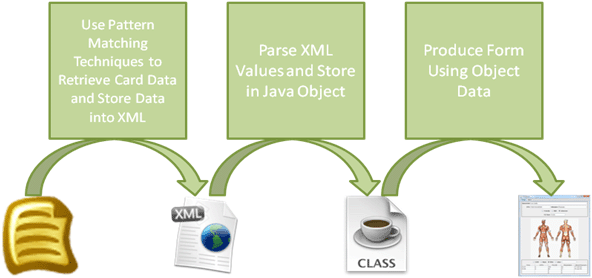
Voice FMC
Voice Field Medical Card
___________________________________________________________________________________________________________________
Student: Jihad Ashkar
This research is supported by the Maryland Technology Development Corporation (TEDCO) Maryland Research and Applied Sciences Consortium (MRASC) Applied Research and Development Project (ARDP) awarded by the United States Army Medical Research and Material Command (USAMRMC) Acquisition Activity. Industry Partner is DSbyte Solutions, LLC.
1. Purpose
To develop a computer software prototype that will automatically create a Field Medical Card based on speech input provided by a combat medic during combat casualty care. The computer software prototype, given a pre-recorded battlefield medic speech data, will translate the speech into corresponding text and use natural language processing (NLP) techniques and external medical terminology to construct textual meaning where a software algorithm can then create an electronic DD1380 Field Medical Card (changed to TCCC Casualty Card). Preliminary speech recognition, speech synthesis, and natural language processing system research shows promise to achieve the desired goals.
2. Description
When an injury occurs on the battlefield, combat medics must arrive at the scene immediately to treat a wounded soldier. The combat medic, after analyzing the injury, would need to retrieve some information on how to perform an appropriate treatment for the soldier. The combat medic would then need to document the injury and any treatment information by completing the field medical card, better known as the Tactical Combat Casualty Care (TCCC) Card. This field medical card is a standard method of communication between the combat medic and the combat physician who will perform further necessary treatments for the wounded soldier. The combat medic may incur difficulties in treating the wounded soldier while retrieving treatment information or documenting the injury and any carried out treatments.3. Approach
We have developed a graphical representation of the TCCC form and a data structure to store the contents of the form in JAVA. We researched various information extraction and pattern recognition techniques and analyzed each approach in order to decide the most appropriate algorithm for our project. The JAVA object to store the information needed to contain all the information needed to complete the TCCC form. The information is stored in a way to correspond with the DA Form 7656 format. The JAVA object stored the information in the format it is presented to the user. It does not deal with the results of the information extraction / pattern recognition technique. Using the information stored in the JAVA object, we generate the JAVA GUI representation of the TCCC form. Generating the form required us to employ JAVA’s Swing library features including but not limited to JFrames, JPanels, JTabbedPanes, JTables, Layout Managers. All necessary tools were used to create the form that most accurately represents the DA Form 7656 format.
Fig. 1: Processing Text to Complete TCCC Card
The XML file was the storage medium for the values extracted from the text file. When we completed the information extraction algorithm, we stored the information in this file. The file was formatted in a manner that facilitated the parsing process to generate the GUI interface. JAVA’s Document Object Model (dom) library was used to create the file. This approach involved creating the root element and populating all child elements which are later added to the root element. Parsing the XML file followed a similar approach. Through the Document Object Model, we retrieved the root element, followed by its children. Our approach checked the attribute of each element and stored the value in the appropriate field in our object.
Fig. 1: Java GUI Representation of TCCC Casualty Card (FRONT and BACK)
Pattern Matching Algorithim
Algorithm to translate the procedure note text file into a TCCC Casualty Card Format.
Related Publications:
Copyright © Sharad Sharma., All Rights Reserved